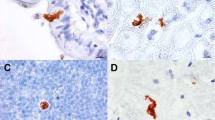Summary
The role of the humoral immune response in clearance or prevention of canine distemper viral encephalitis of dogs infected with a virulent strain of canine distemper virus has been evaluated. Dogs that have demyelinating lesions, CDV proteins and infectious virus in their brains demonstrate an impaired humoral immune response. In dogs that recover from infection and contain no demyelinating lesions, viral proteins or infectious virus in the brain, antibodies to the internal proteins of CDV are observed early after infection. Later antibodies to primarily the H protein are detectable in sera of these dogs and the appearance of antibodies against the surface glycoprotein (H) correlates with the absence of lesions, CDV antigen and infectious virus in the brains of these dogs. Very late after infection immunoprecipitating antibody to all CDV antigens diminished rapidly so that at about ten weeks post infection antibodies that precipitate CDV antigens are barely detectable.
Similar content being viewed by others
References
Appel MJG (1969) Pathogenesis of canine distemper. Am J Vet Res 30: 1167–1181
Appel MJG, Robson DS (1973) A microneutralisation test for canine distemper virus. Am J Vet Res 34: 1459–1463
Appel MJG, Shek WR, Summers BA (1982) Lymphocyte-mediated immune cytotoxicity in dogs infected with virulent canine distemper virus. Infect Immun 37: 592–600
Casali P, Rice GPA, Oldstone MBA (1984) Viruses disrupt functions of human lymphocytes. Effects of measles virus and influenza virus on lymphocyte-mediated killing and antibody production. J Exp Med 159: 1322–1337
Cosby SL, Morrison J, Rima BK, Martin SJ (1983) An immunological study of infection of hamsters with large and small plaque canine distemper viruses. Arch Virol 76: 201–210
Drillien R, Spehner D, Kirn A, Giraudon P, Buckland R, Wild F, LeCocq JP (1988) Protection of mice from fatal measles encephalitis by vaccination with vaccinia virus recombinants encoding either haemagglutinin or the fusion protein. Proc Natl Acad Sci USA 85: 1252–1256
Hall WW, Imagawa DT, Choppin PW (1979) Immunological evidence for the synthesis of all canine distemper virus polypeptides in chronic neurological diseases in dogs. Virology 98: 283–287
Krakowka S, Olsen R, Confer A, Koestner A, McCullough B (1975) Serologic response to canine distemper viral antigens in gnotobiotic dogs infected with canine distemper virus. J Infect Dis 132: 384–392
Krakowka S, Cork LC, Winkelstein JA, Axthelm MK (1987) Establishment of the blood-brain barrier and facilitation by antiviral antibody. Vet Immunol Immunopathol 17: 471–482
Lamb RA, Etkind PR, Choppin PW (1978) Evidence for a ninth influenza viral polypeptide. Virology 91: 60–78
Love A, Rydbeck R, Utter G, Orvell C, Kristensson K, Norrby E (1986) Monoclonal antibodies against the fusion protein are protective in necrotizing mumps meningoencephalitis. J Virol 58: 220–222
Miele JA, Krakowka S (1983) Antibody responses to virion polypeptides in gnotobiotic dogs infected with canine distemper. Infect Immun 41: 869–871
Mitchell WJ, Summers BA, Appel MJG (1991) Viral expression in experimental canine distemper demyelinating encephalitis. J Comp Pathol 104: 77–87
Norrby E, Utter G, Örvell C, Appel MJG (1986) Protection against canine distemper virus in dogs after immunization with isolated fusion protein. J Virol 58: 536–541
Örvell C, Sheshberadaran H, Norrby E (1985) Preparation and characterisation of monoclonal antibodies directed against four structural components of canine distemper virus. J Gen Virol 66: 443–456
Rima BK, Baczko K, Imagawa DT, ter Meulen V (1987) Humoral immune responses in dogs with old dog encephalitis and chronic distemper meningo-encephalitis. J Gen Virol 68: 1723–1735
Summers BA, Greisen HA, Appel MJG (1978) Possible initiation of viral encephalomyelitis in dogs by migrating lymphocytes infected with distemper virus. Lancet i: 187–189
Summers BA, Greisen HA, Appel MJG (1979) Early events in canine distemper demyelinating encephalomyelitis. Acta Neuropathol 46: 1–10
de Vries P, Uytdehaag FGCM, Osterhaus ADME (1988) Canine distemper (CDV) immune-stimulating complexes (iscoms) but not measles virus iscoms, protect dogs against CDV infection. J Gen Virol 69: 2071–2083
Author information
Authors and Affiliations
Rights and permissions
About this article
Cite this article
Rima, B.K., Duffy, N., Mitchell, W.J. et al. Correlation between humoral immune responses and presence of virus in the CNS in dogs experimentally infected with canine distemper virus. Archives of Virology 121, 1–8 (1991). https://doi.org/10.1007/BF01316739
Received:
Accepted:
Issue Date:
DOI: https://doi.org/10.1007/BF01316739




